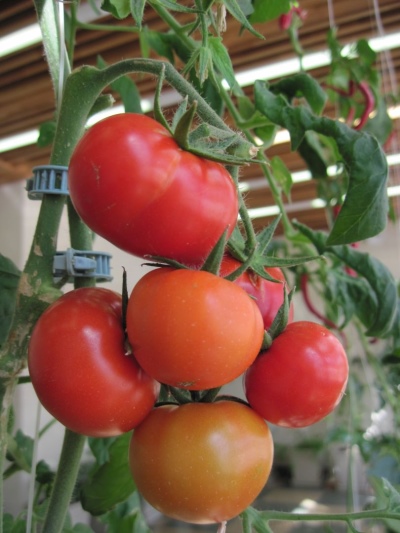
- Authors: Kachainik V.G., Gulkin M.N., Karmanova O.A., Matyunina S.V. (Agrofirma Aelita LLC)
- Year of approval: 2015
- Category: grade
- Growth type: indeterminate
- Appointment: fresh consumption, for pickling and canning, for whole-fruit canning
- Ripening period: mid-season
- Ripening time, days: 111-115
- Growing conditions: for open ground, for film greenhouses, for greenhouses
- Bush size: tall
- Bush height, cm: 300
Tomato variety Senior Tomato has been approved for use since 2015. It is grown in open soil, as well as in film greenhouse structures.
Description of the variety
The senior tomato has an indeterminate type of growth. The bushes are tall. The height of an adult plant can be about 300 centimeters. The bush has a weak leafiness. The leaves on it are medium-sized green saturated colors.
The main qualities of the fruit
Unripe tomatoes will be light green in color with a slight green spot. Ripe vegetables have a bright red color. The size of the fruits is average, the weight of each vegetable is on average 63 grams. Their shape is heart-shaped, slightly ribbed.
One cluster may contain 20-30 fruits. At the same time, 4-5 brushes grow on the main stem. The pulp of vegetables is of medium density, quite fleshy. Their keeping quality is 1-1.5 months.
Taste characteristics
Señor tomato has excellent taste characteristics. Ripe fruits can be used for fresh consumption, as well as for canning.
Ripening and fruiting
This variety of tomatoes is mid-season. Ripening dates are about 111-115 days after planting in the soil. Harvesting takes place from July to September.
Yield
The variety is considered a high-yielding variety, it allows you to harvest about 5.9-7.4 kilograms of ripe tomatoes from 1 square meter. From one healthy adult bush, you can get 20-25 kilograms of vegetables per season.
The timing of planting seedlings and planting in the ground
Sowing for seedlings is carried out from March 1 to March 15. Landing in open ground takes place from May 15 to June 5. In this case, the seedlings should reach an age of 60-65 days.

Growing tomato seedlings is an extremely important process, because it largely depends on whether the gardener will be able to harvest at all. All aspects must be taken into account, from seedbed preparation to planting in the ground.
Landing scheme
Landing is carried out according to the scheme of 60x50 centimeters. At the same time, the planting density is 3-4 plants per 1 square meter.

Growing and care
It is important to grow strong seedlings for outdoor planting. To do this, you need to prepare an earthen mixture. It should consist of garden soil and humus, the components are taken in equal proportions. And you can also supplement all this with wood ash or mineral fertilizer.
The earth will need to be spilled with a heated solution of potassium permanganate. A biological fungicide is sometimes used. Then the mass is laid out in plastic containers. It must be moisturized.
Seed material is carefully laid out on top of the ground, and then deepened a little. Each container should be packed with two seeds.After that, the seeds are sent to a windowsill located on the sunny side. It is necessary to ensure the temperature in the boxes is 25-26 degrees. To do this, you can cover the vegetation with a special film. The first shoots should appear in about 4-5 days.
After 60-65 days, the seedlings are planted in a permanent place. In this case, you first need to find a suitable place on the site. These tomatoes prefer soils that are rich in organic components, so you should pre-treat the area with humus or compost (5-6 kg per 1 square meter).
It is also recommended to make top dressing with potassium. The planting holes must be well moistened. Then the seedlings are placed there. This must be done with the utmost care so that the root system is not damaged.
After transplanting to a permanent place, the seedlings can be covered with a special film. This will keep the vegetation free from drafts. When the weather is warm, such a covering material is removed. After 10 days after planting, abundant watering is carried out.
In the future, watering is carried out as the soil dries out. At the same time, excess moisture should not be allowed near the vegetation. This can cause various fungal diseases. It will be possible to carry out drip irrigation.
Tomatoes need to be fertilized three times per season. Most often, formulations with ammonium nitrate, superphosphate, potassium chloride are used. A solution with poultry droppings is often used.
Boron will do. It is taken during flowering so that the flowers and ovaries do not crumble. To prepare the composition, you need to mix 1 gram of boric acid and 1 liter of liquid. The finished solution is sprayed on the culture, it is recommended to do this in the afternoon.
Bushes will also need to be tied to supports. It is best to do this immediately after planting. The procedure will allow the bushes to take root well. The culture in the process of growth should be protected from weeds. For these purposes, loosening and hilling are carried out.
To get a good harvest, it is required to carry out the formation of the bush and the regular removal of stepchildren. Only 1 main stem can be left. But sometimes it allows 2-3 stems.
In mid-August, pinch the top of the fruiting shoots. Brushes are also removed where the fruits have not set.




A plant needs different micronutrients at each stage of growth. All fertilizers can be divided into two groups: mineral and organic. Folk remedies are often used: iodine, yeast, bird droppings, eggshells.
It is important to observe the rate and period of feeding. This also applies to folk remedies and organic fertilizers.



























































































